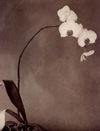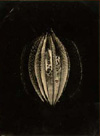 |
 |
 |
 |
 |
 |
A print made on paper coated with an egg-white and salt solution sensitized with silver nitrate and exposed to sunlight through a negative. Invented in France in 1850 by Louis-Désiré Blanquart-Evrard (1802-72), it was the most common type of photographic print until about 1890. Albumen prints were often toned with gold chloride to cool the brown color and improve the permanence of the photograph.

Matte albumen print
by Zoë Zimmerman
Ambrotype
An underexposed and then developed collodian
negative on glass, usually backed with a dark
opaque coating, such as black lacquer, and presented in a small hinged case.
Named after the American James Ambrose Cutting (1814-67), they were most often
used
to make portraits and by the late 1850s had largely replaced the more costly
daguerrotype.

Ruby collodian ambrotype
by France Scully Osterman
The earliest negative/positive paper process, patented by Englishman William Henry Fox Talbot in 1841. A latent image produced by exposing paper sensitized with potassium iodide and silver nitrate solutions in a camera is developed and the resulting positives are contact printed in daylight on salted paper that has also been treated with silver nitrate.

Long Live Holga
(2002),
Calotype
by Stephanie Shuster
Cyanotype
A sheet of paper is brushed with solutions of iron salts and
potassium ferricyanide and placed in contact with a negative or other matrix.
The surface darkens when exposed to light and the resulting image, which is
developed in regular tap water, is usually white on a blue background.

Cyanotype
by John Dugdale
Wet-plate or collodian photography was invented in 1851 by the Englishman Frederick Scott Archer. In the process a glass plate is coated with a light-sensitive emulsion of collodian - gun cotton dissolved in alcohol and ether - to which potassium has been added. The plate is inserted in the camera and exposed while still wet. The plate is then developed and fixed. Colllodian can produce either a negative on glass or a positive image if underexposed, backed with dark material, and viewed by reflected light. The process displaced the daguerrotype and calotype processes and was the most popular negative process from the mid-1850s to the 1880s. It was eventually superceded by the gelatin dry plate
48 x 38 in.
Silver gelatin enlargement from collodian negative
by Sally Mann

The invention of this first photographic process was announced in 1839 by Louis-Jacques-Mandé Daguerre (1787-1871). The image is formed on a copper plate coated with highly polished silver that is sensitized by fumes of iodine to form silver iodide. After exposure, the latent image is developed in mercury vapor, resulting in a unique reversed image that was often presented in a small hinged case. Each daguerrotype is unique and permanent, but the process went out of fashion after the introduction of the wet collodian process in the 1850s.

Daguerrotype
by Robert Shlaer
Cibachrome photogram by
Adam Fuss

A photographic image made without a camera, either by placing objects on a sensitized surface (paper or film) that is exposed to light, or simply by directing light onto the material.
A salt print is made on fine-quality writing paper coated by hand with light-sensitive chemicals. This is the earliest form that was used for printing calotypes and other paper negatives. The tones are generally shades of brown and purple, and, because the emulsion soaks into the paper, the prints tend to have a matte surface quality.

Competing Conditions
(1999),
4 x 3 1/2in.
Gum bichromate salt print with watercolor
by Dan Estabrook
Tintype
A unique positive image formed by exposing a thin sheet of
iron varnished with black lacquer with sensitized collodian in a camera. During
the 19th century tintypes were used almost exclusively as a way to make inexpensive
portraits.

Tintype by
Jayne Hinds Bidaut